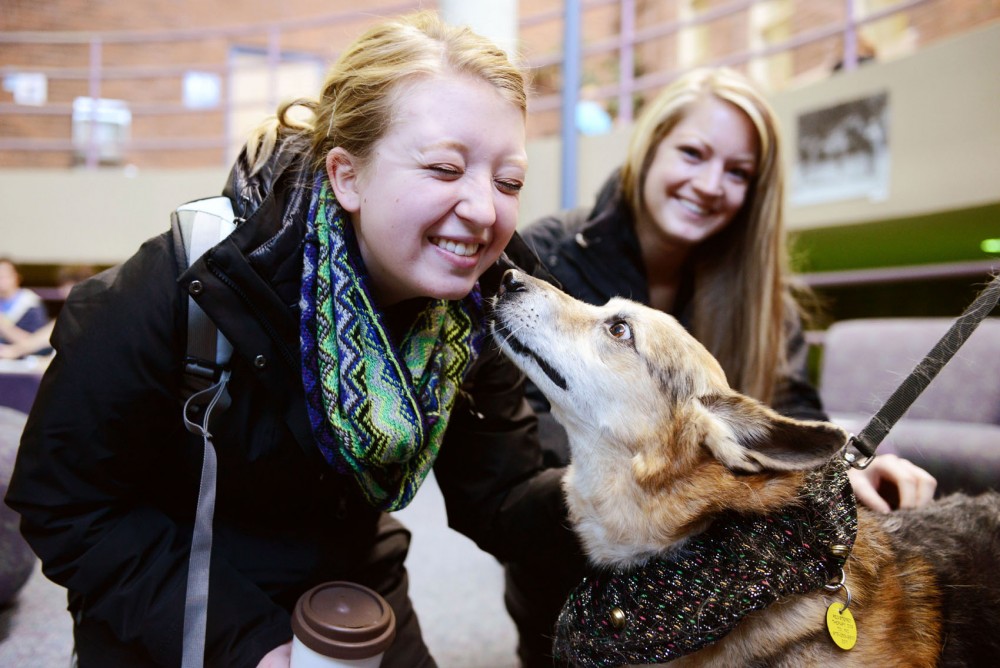To diffuse finals week tension, the University of Minnesota’s Center for Spirituality and Healing brought out its toughest reinforcements: a 4-year-old golden retriever, a corgi-German shepherd mix and a silkie chicken named Woodstock.
The center partnered with the Magrath Library to bring animals trained in Animal-Assisted Interactions, commonly known as animal therapy, to the St. Paul campus Monday. They will be available to students in the Learning and Environmental Sciences building between 10 a.m. and 2 p.m. until Wednesday, the final day of classes.
Megan Unrau said she has a lot on her plate during the last week of classes, so she was excited to interact with Gopher the golden retriever.
“It’s relaxing,” the graphic design major said. “Sometimes you just need a little time with an animal to help calm you down.”
According to the National Research Center for Women and Families, animal interaction has been shown to lower blood pressure, heart rates and anxiety in humans.
“Students are looking for a way to release tension,” said Kristen Mastel, a University librarian. “Petting an animal is a natural way to release tension.”
With finals week approaching, Mastel said “pet-deprived” students are in greater need for stress relief.
The AAI animals are trained to partner with people to focus on emotional, social, cognitive, physical and spiritual well-being, said clinical social worker Tanya Bailey, who is a new addition to the University’s Animal-Assisted Interaction Programs.
Gopher the dog works at children’s hospitals and with Reading Education Assistance Dogs, a literacy program where people with reading disabilities read to AAI-registered animals, said Chad Burgess, Gopher’s handler.
Burgess said being around the dogs relaxes people and provides them with a “non-judgmental” atmosphere where they can improve their reading abilities.
‘A mental massage’
Bailey said a barrier she’s faced working in AAI is that it’s not taken seriously.
“I think up until recently, this wasn’t considered hard science,” Bailey said. “It was much considered silly.”
Bailey said the University recently hired her as part of a new initiative to help expand the AAI field in academia through research and coursework development.
Larson said AAI works because of the Attention Restoration Theory — the idea that focusing on an animal, or any element of nature, allows the brain to relax.
“It’s like a mental massage,” she said. “And when you go back to studying, your brain has a new energy. It’s been revitalized.”
This week’s events are also promoting awareness for a University course, Animals in Healthcare, said Jean Larson, the course instructor.
Students in the class get hands-on experience working with dogs, horses, cats, guinea pigs, rabbits and other animals in AAI settings, Larson said.
She said it’s important to note that animals aren’t being “used” to treat people — AAI only works when animals show interest.
“They are just as involved with the process as we are,” Larson said. “It’s always a partnership working with the animals.”
One of Bailey’s main AAI partners is Woodstock, a 6-year-old silkie chicken.
“She’s just this little fluff puff of feathers,” Larson said. “She’s just hilarious.”
Bailey said Woodstock makes for a good AAI partner because people don’t expect a chicken to do this type of work.
Woodstock, a mellow hen, is usually content sitting in her basket or on a person’s lap.
Bailey said petting the hen can have a meditative effect because a person’s entire face and body usually relaxes during the process.
Larson said she’s hoping to make these pre-finals week animal sessions a campus tradition.
“It’s probably been the best part of my day,” said Cassy Tessier, a family social science student. “Now I’m probably going to head back and study all day.”


